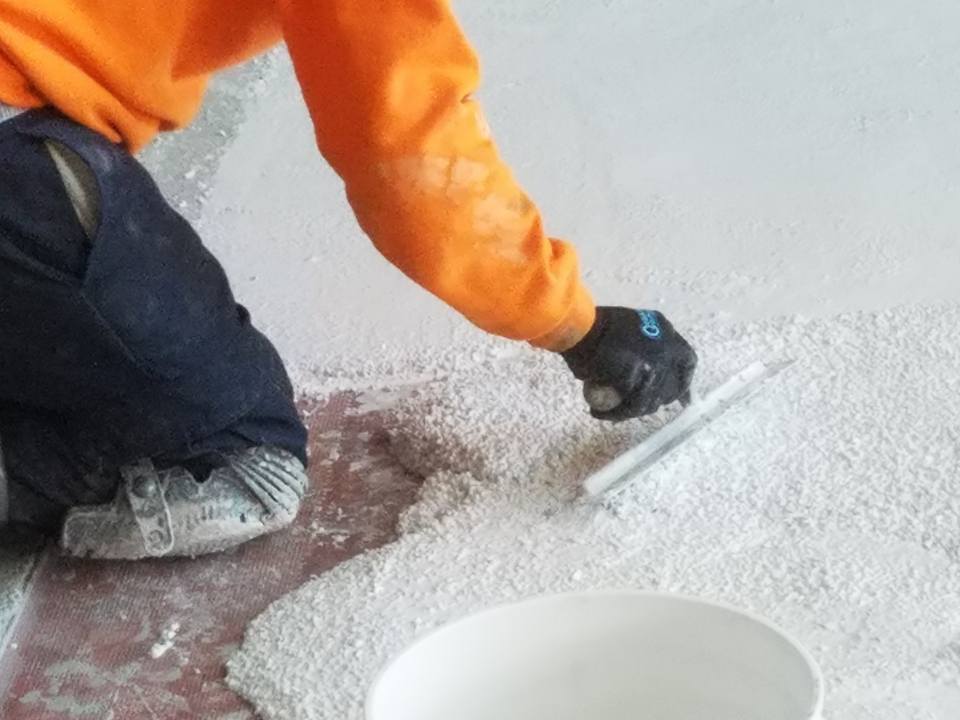Terrazzo Flooring Process
Terrazzo has been passed down from generations. Gone are the days when construction workers used a galera, a long-handheld tool used to grind the terrazzo surface. Today advancements in terrazzo allow installers to complete projects faster and in much safer working conditions. However, there are a set of steps that installers must follow when working with terrazzo. These steps include:
- Shot Blasting
- Floor Preparation
- Design Layout
- Pouring
- Grinding
- Grouting
- Polishing
- Sealing
After samples are approved and materials are shipped to the project’s site, a construction team can begin installing terrazzo.

Shotblasting
Floor preparation is key to a successful terrazzo project. First, installers need to prepare the surface for a strong bond between the terrazzo and concrete. During the shotblasting stage, the top layer of concrete is removed to reinforce this bond.
Floor Preparation
During this stage, installers will observe signs of possible defects already existing within the floor’s surface. Installers will check to see if there are any cracks visible in the substrate floor, test for excessive moisture present, and check the leveling of the surface.
If cracks are present, an installer can use a flexible membrane to cover up any cracks to make sure no issues arise during and after the finished terrazzo installation.
In case moisture levels are high, an installer can use a moisture mitigation system, which applies a thin layer on top of the substrate floor that prevents moisture from diffusing through the terrazzo floor once installed.
If floors are uneven, an installer can apply a fill epoxy, which will level out the floor evenly for a nice smooth terrazzo finish.
Design Layout
The next step prior to pouring terrazzo is the design layout. Terrazzo is an art form that uses divider strips that serve to control expansion joints and separate multiple epoxy resin colors. Dividers strips can be coordinated to create complex design patterns or even the most amusing floor designs.
Terrazzo Mix
Terrazzo is a combination of marble, glass or other decorative aggregates joined with either a cementitious or epoxy binder. Using the specified materials, an installer will mix the aggregates, epoxy resin, and epoxy hardener together to form a new terrazzo mix.
Pouring Terrazzo
Installers will carefully pour terrazzo onto the surface, using a hand or power trowel to spread the mixture evenly. If areas call for multiple colors, the installers will create new batches, filling in the terrazzo mix according to the design layout specified. Allow for the terrazzo to cure before proceeding to the next step.
Grinding Terrazzo
Once the terrazzo is cured, installers can now grind the terrazzo using a floor grinding utilizing diamond-plated grinding pads rotating at fast speeds. Grinding the terrazzo will transform the floor from a rough to smooth texture. Once completed, the entire floor should look even, smooth, and radiant than before.
Grouting Terrazzo
As follows, an installer will grout the terrazzo to cover any pinholes present in the surface.
Polish and Sealing Terrazzo
Next, an installer polishes the terrazzo giving the surface a nice shine. To follow up, an installer will use a water-based solvent to seal the terrazzo floor, which gives the floor more radiance and extra protection.
For more information on terrazzo, visit the NTMA.com or download one of our case studies:
How to Maintain Terrazzo Floors
Doyle Dickerson Terrazzo helps building owners find floors that will last a lifetime, leaving a lasting impression with its aesthetic beauty. For a quote or free consultation on terrazzo, call Doyle Dickerson Terrazzo today at (704) 921-4940.

